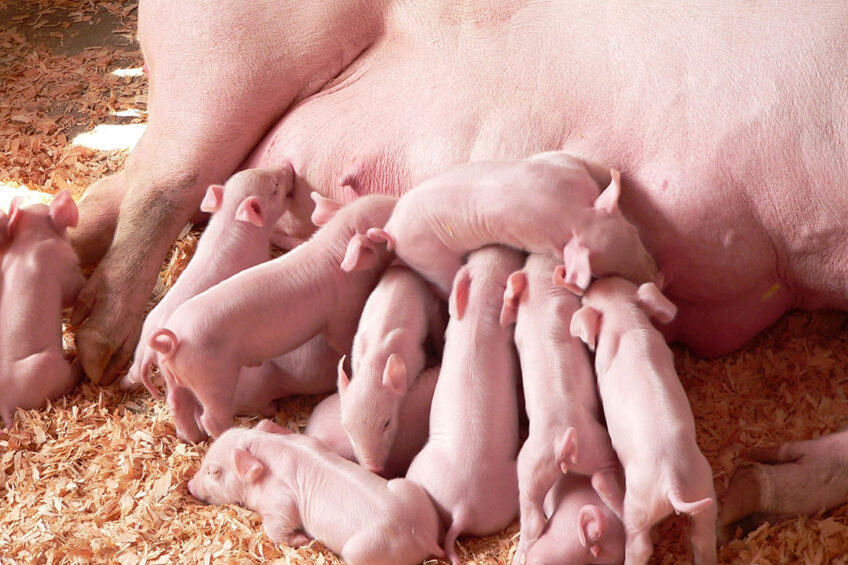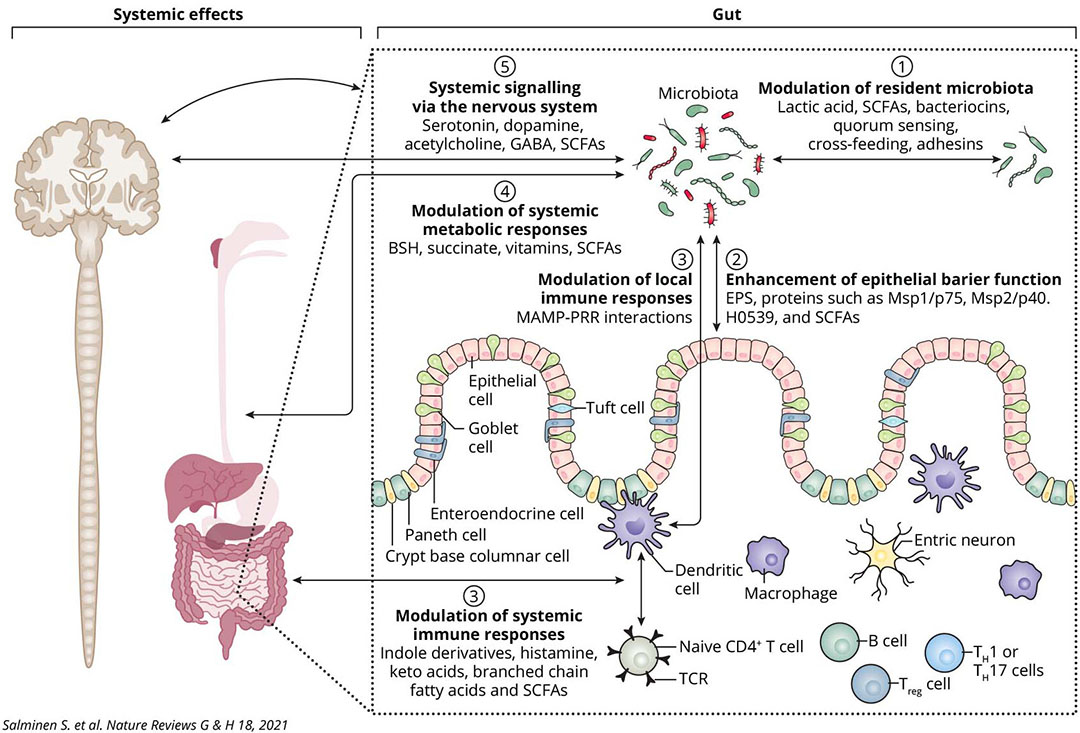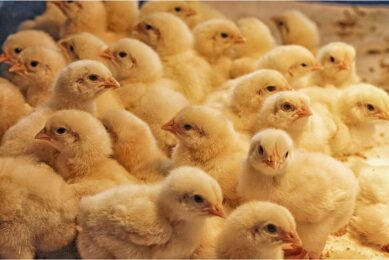Postbiotics: A new era in gut health

Animal nutrition includes feeding the microbiome. Using functional fibres for the microbiome and postbiotics, including fermentation products, is paramount for maintaining intestinal integrity.
Part of the Gut Health 2022 Special
Gut health is maintaining intestinal integrity and barrier function: reducing the risk of overstimulation of the immune system (gut inflammation), decreased nutrient absorption and performance (growth and milk production). The integral role of microbial metabolites (coined postbiotics) in modulation of the microbiota, intestinal integrity, the immune response, metabolism and brain activity is becoming increasing clear (Figure 1). Nutritional manipulation of gut health for piglet starts pre-birth at the end of the gestation period and during the lactation period. These two critical periods determine lifetime performance of hyperprolific sows and their progeny especially in the post ZnO era.
Figure 1 – The physiological, immunological and psychological role in postbiotics.

Gut health from inside
Animal nutrition includes feeding the microbiome (the complex community of microbes residing in the gut), for example by including functional fibres and postbiotica. Fermentation of complex carbohydrates produces volatile fatty acids of which especially butyric acid is important as an energy source for enterocytes, stimulating gut development. Fermentation of complex carbohydrates in combination with protein (amino acids like tryptophan, phenylalanine & tyrosine) forms bio-active microbial metabolites, or postbiotics, like ILA (indole lactate), IPA (indole propionate acid), IAld (Indole aldehyde), PA (Phenyl acetate), PEA (Phenyl ethylamine) etc. They act as signalling molecules, stimulate endothelial cell proliferation and differentiation including the immune response in the GALT (gut associated lympoid tissue). As small molecules they can easily cross the cell membrane and bind to the AhR (aromatic or aryl hydrocarbon receptor), upregulating the mRNA transcription for anti-inflammatory cytokines (IL- 10) and antimicrobial peptides (IL-22 from Paneth cells) and stimulate mucus production from goblet cells. The liver receives all portal blood and its metabolites. Hepatocytes also have AhR: postbiotcs stimulate detoxification and the IGF-1 production (via GH (growth hormone) and GHR) affecting protein deposition and energy metabolism.
Decreased intestinal barrier function
Compromised gut health, due to constipation or diarrhoea, results in (endo-, hepato- and neuro) toxic microbial metabolites production from f.i. ileal undigested protein fermentation of sulphur containing amino acids like cysteine, pCS (p-cresol sulfate) and indoxylsulfate. The paracellular migration of endotoxins (LPS), enterotoxins (gut microbial metabolites like biogenic amines) and/or xenobiotics (mycotoxins) caused by a decreased intestinal barrier function or the ‘leaky gut syndrome’, leads to an upregulation of the mRNA expression (and production) of pro-inflammatory cytokines like IL-6, IL-8 and TNF-α and a decrease in anti-inflammatory cytokines like IL-10 and IL-18. The latter is involved in epithelial repair, including synthesis of tight junction (Zona Occludens) proteins.
Metabolic diseases
Postpartum Dysgalactia Syndrome (PDS), reported in 1 out of 8 sows, is a consequence of this. The ‘start up’ problems with feed intake and (colostrum) milk production lead to decreased piglet vitality, increased mortality and the on-set of the Negative Energy Balance (NEB). PDS is visible as udder inflammation, rectal temperature >39.5 oC, feed refusal and piglets searching for milk.
Swine Inflammation and Necrotic Syndrome (SINS) affecting the pregnant sow and her unborn piglets is another metabolic disease cause by the leaky gut syndrome and placental transfer of absorbed gut toxins. The visible signs in new born piglets include inflammation of the tail, ears and claws. It is likely that these also can cause inflammation of the gut, liver and other organs and might be an underlying cause of IUGR.
A progressive increase in litter size has led to a higher portion of Intra Uterine Growth Restriction (IUGR) piglets. With some sows this reaches 20-30% of piglets have a birth weight of less than 1100 gram. IUGR piglets have less developed organs, the small intestinal weight to length ratio is severely reduced, microvilli are reduced and shorter, and mucosal immunity is compromised. This compromised intestinal integrity leads to the high mortality and low growth. Stimulating gut development of IUGR piglets should be done in the lactation period because the relative growth (ADG/kg BW) of IUGR piglets is considerable higher than normal birth weight piglets. Insulin resistance (metabolic syndrome) naturally develops at the end of the gestation period in sows (in order to increase placental glucose transfer to the fast growing unborn piglets) increases oxidative stress on the gut. This is an underlying cause of the leaky gut syndrome increasing the absorption of gut toxins. Feeding a (transition) feed with high levels of inert carbohydrates, from feedstuffs, feed additives or roughages (straw) decreases IUGR and stimulates lactation feed intake.
Optimum feed intake during transition period
The transition period is from when sows are moved into the farrowing room, one week before parturition, till 3-5 days postpartum. In practise daily feed allowance in this period is often too low, resulting in body condition losses in the last part of the gestation period and decreasing gut health. Optimum feed intake is important in hyperproductive sows during the transition period for shortening the farrowing period, farrowing assistance and the number of stillborn piglets. High feed intake levels are possible in the transition and help increase early feed intake and milk production after farrowing. Adding a postbiotic like Lianol Vital in the transition period will improve gut health of the sow and reduce the stress caused by the farrowing process. Further adding the postbiotic Solapro, at a rate of 0.10% will improve feed intake and reduce the NEB during the lactation period, improving weaning weight and improving fertility in the next cycle. The window of opportunity to prepare the sow and her piglets for farrowing, lactation and subsequent weaning of piglets and insemination of the sow, lies in the transition period. The role of functional fibres for the microbiome and postbiotics, including supplemented fermentation products, for maintaining intestinal integrity and stimulating energy and protein metabolism (IGF-1) is paramount.
References available on request.
 Beheer
Beheer






 WP Admin
WP Admin  Bewerk bericht
Bewerk bericht